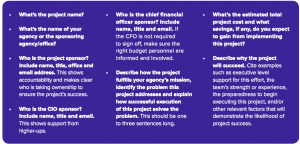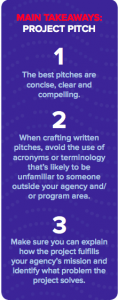This article is an excerpt from GovLoop’s recent guide, “Making IT Work: A Practical Guide to Modernization in Government. Download the full guide here.
Have you ever watched the T.V. show “Shark Tank?” If so, then you know the best pitches are concise, clear and compelling. Successful entrepreneurs can quickly show the value of their brainchild and clearly articulate what they have already invested, what they need and how that money will be used and eventually repaid.
For the most part, pitching project ideas in government is no different. Federal agencies are capitalizing on this “Shark Tank” model to pitch and fund high-impact technology projects that will improve citizen services, boost security and reduce outdated and insecure systems.
A solid modernization pitch has sponsorship from higher-ups and shows a strong likelihood of successful outcomes and savings. Admittedly, they are not the flashiest projects, but changes that align with the mission, empower staff to better serve the public and promise lasting impacts are more likely to garner support.
Depending on your agency’s size and structure and the magnitude of the project, you must account for specific nuances. For example, if you are tackling a smaller project on your own, that will require different resources and a slightly different approach than if you are at a larger agency with multiple governance and review boards. We’ve adapted templates from the Technology Modernization Fund Board that you can easily tailor to meet your agency’s needs. You can use these prompts and questions as a starting point.
The initial proposal outline highlighted below includes several general questions you should be able to answer when pitching a modernization project. Notice that this is not a lengthy government business case but rather a short document that provides senior leaders with enough information to make an initial determination about the project and whether it’s worth exploring and potentially investing in. When crafting your responses, avoid using acronyms or terminology that’s likely to be unfamiliar to someone outside your agency and/or program area.

How to Do Small-Scale Project Pitches
 Until this point, we’ve discussed modernization in terms of calculated steps and questions that you and your team should ask before pitching a project. But things are not always that clear-cut. Sometimes modernization is less like a team sport, where you have a deep bench of expertise and multiple layers of leadership.
Until this point, we’ve discussed modernization in terms of calculated steps and questions that you and your team should ask before pitching a project. But things are not always that clear-cut. Sometimes modernization is less like a team sport, where you have a deep bench of expertise and multiple layers of leadership.
For state and local governments, where staff sizes are often smaller than those at federal agencies, navigating the modernization landscape can be tough — but not impossible.
Levi Worts, a Technical Writer at the Montana Motor Vehicle Division, is proof. He spearheaded a “rogue” project at his agency that disrupted the entire digital customer service experience — for the better.
The idea to modernize came after Worts moved his office space and began overhearing complaints from customers at the driver’s license station. After determining that the main point of friction was the website, Worts did more homework.
“I knew the website, being tasked with updating information on it; I even compiled a style guide to clear up inconsistencies, but even I had trouble finding information,” Worts wrote in a recent GovLoop article. “The need was obvious, so I was determined to do something about it.”
He approached his administrator with a request to redesign the website. She agreed, mentioning that it was on the list of to-dos, but it was toward the bottom. She concluded that he could work with the Montana Department of Justice’s webmaster if he wanted, but he’d be going forward on his own.
This is one of the realities that you are likely to face if your pitch is approved. Managers are hesitant to lend additional time and resources to a project that did not originate with them (or another higher-up) or has not proven its worth.
The initial pitch was not the end for Worts. He later had to pitch the idea of developing a chatbot to integrate into all aspects of the agency’s website. The takeaway here is, in your quest to sell a modernization project, be prepared to offer multiple pitches to shed greater light on what you hope to accomplish and any updates along the way.
For more insights on how Worts pitched his rogue project and transformed the digital customer experience, check out his series of articles at govloop.com/author/leviworts/.





Leave a Reply
You must be logged in to post a comment.